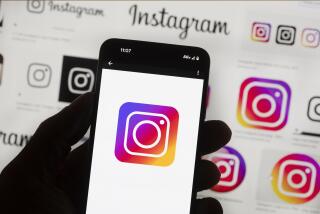Facebook, Twitter try to grab teens’ attention with new features

SAN FRANCISCO — Facebook Inc. and Twitter Inc. are going after the only thing more fleeting than a Snapchat message: the teenage attention span.
On Thursday, Instagram, the photo-sharing service owned by Facebook, introduced a way to send private messages with photos and videos. And Twitter this week added the ability to send photos — not just text — in private messages.
Though both services gained popularity for letting users express themselves publicly, they are now also giving users the choice to share photos privately.
The moves are designed to compete with the growing popularity of private messaging services such as WhatsApp, Kik and Snapchat, a hit with teens because it lets users send messages that disappear after they’ve been read.
Analysts say there was nothing groundbreaking about either announcement this week. And, they say, Instagram and Twitter will have to come up with new ways to reach teens if they want their picture-sharing apps to remain relevant.
“This is a catch-up move,” Forrester Research analyst Julie Ask said.
Teens agreed. Maher Hammoudeh is a 15-year-old high school junior from Alameda, Calif., and an avid Instagram user. On Thursday he updated his Instagram app during his lunch hour and sent a couple of messages to friends.
“Most of my friends are saying it’s pointless because of Snapchat. They are not really using it,” Maher said of the new Instagram messaging feature.
He said Instagram should focus on coming up with something more original to get teens to spend more time there.
“For our generation, it’s better to come up with new ideas that help teenagers use their electronics for a new reason,” Maher said.
Just a couple of years ago, Instagram was the new thing: a photo-sharing app that teens use to chat with one another. Now it’s one of the incumbents, trying to fight off nimble competitors for those precious minutes and hours teens spend on mobile devices.
The good news for Instagram: Teens are not using just one service to connect with friends and the world.
“Teens’ engagement with different technologies is really about who’s there and what the norms are in a particular peer group surrounding the given service,” said social media researcher Danah Boyd, author of “It’s Complicated: The Social Lives of Networked Teens.”
“Right now, Facebook is the place for dealing with everyone in your network, for better and worse,” Boyd said. “Twitter is for engaging around shared interests, celebrities, or generally being a part of public life. Snapchat is for one-on-one ephemeral interactions. WhatsApp is for a small group of friends, etc.”
But keeping young people focused on Facebook is proving to be a real challenge for the Menlo Park, Calif., company. With parents, relatives and teachers all crowding the social network, teens say they are just not that into it. Instead, they prefer chatting with friends in more intimate ways.
Nick Goodacre, a 15-year-old high school freshman at Maria Carrillo High School in Santa Rosa, Calif., says he rarely logs into his Facebook account, and instead mostly sends texts or messages on Kik so conversations with friends remain more private.
Lily Gack, a 15-year-old sophomore at Santa Rosa High School, says she doesn’t even have a Facebook account and many of her friends don’t either.
Facebook acknowledged that teens were losing interest in the service during its third-quarter earnings call. That waning interest drove its purchase last year of Instagram for $1 billion in cash and stock.
Instagram now has 150 million users, up from 80 million at the start of the year. More than half of them use the service every day.
But Forrester’s Ask says it’s likely that Instagram, too, is beginning to see its once-feverish growth rate beginning to cool off.
Instagram is looking to keep teens enamored with Instagram Direct, which lets them start a private conversation with 15 or fewer friends, instead of having to post a photo or video for their followers to see.
Analysts say it’s unclear whether the new messaging feature will be enough to keep teens’ attention from wandering.
Already, Lily says she doesn’t spend as much time as she used to on Instagram.
“I used to use it more,” she said. “Now I don’t really scroll around on it that much anymore unless I am really bored or I am procrastinating.”
She said that she’s sure teens will use the private messaging feature but that she’s unlikely to switch to Instagram. She mostly texts or uses Snapchat to message friends, she said.
Facebook tried rolling out a Snapchat competitor a year ago. But the self-destructing message app called Poke never caught on.
Which is one of the reasons Facebook recently tried to buy Snapchat for $3 billion. Snapchat spurned the offer and instead swiped Instagram business chief Emily White as its new chief operating officer.
“I think honestly what they are trying to do is trying to get back at Snapchat for rejecting Mark Zuckerberg’s offer,” Maher said. “They are trying to come back at Snapchat and put it out of business. But I don’t think Instagram is going to be as successful as Snapchat.”
Twitter: @jguynn






